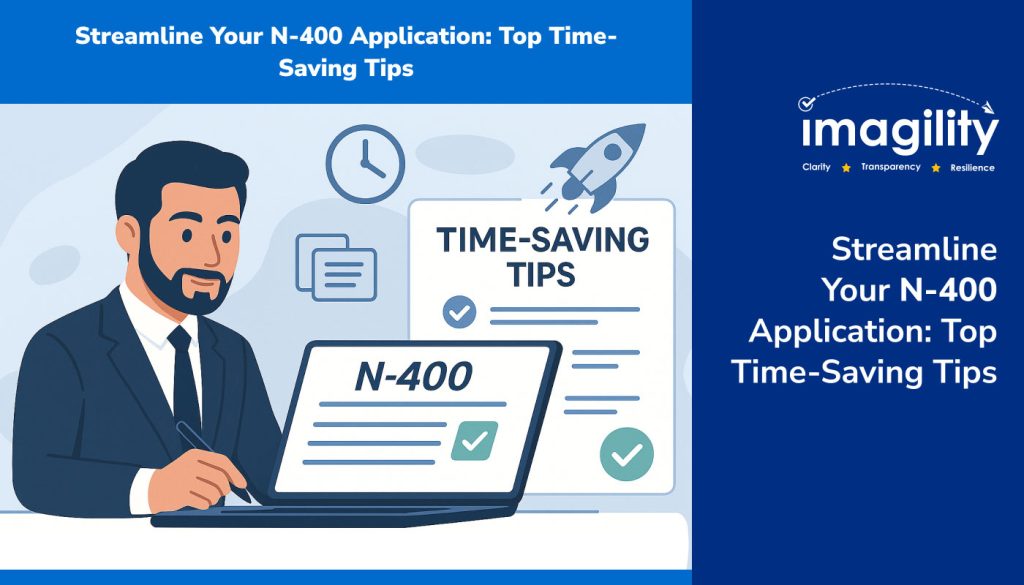Handling Form N-400, the Application for Naturalization, can be a complex and time-consuming task for immigration attorneys. Managing large volumes of client data, navigating intricate eligibility requirements, and working under pressure to avoid delays or denials often leads to workflow bottlenecks.
In this blog, we’ll break down the essential components of Form N-400, highlight common challenges attorneys face and share time-saving strategies that can help attorneys streamline the entire N-400 application process and deliver a better client experience.
Here we go!
What Information Does Form N-400 Require?
Form N-400 requires detailed client information across several categories. While USCIS provides comprehensive instructions, here’s a simplified breakdown of the key components you’ll need to address:
- Personal Details: Full legal name, date of birth, physical traits, and ID numbers.
- Marital & Family Info: Spouse and children details, prior marriages with legal documentation.
- Employment & Education: Five years of work and school history for physical presence verification.
- Background Information: Moral character, criminal records, misrepresentations, affiliations.
- Travel History: All international trips within the past five years.
- Immigration History: A-number, country of citizenship, date of obtaining permanent residency.
- Residential History: Past five years of addresses.
- Civics & Language Requirements: Responses about eligibility for exemptions.
- Selective Service: Proof of registration for male applicants aged 18–26.
- Oath of Allegiance: Willingness to uphold the U.S. Constitution and serve when required.
- Signatures: Applicant, preparer, and interpreter.
N-400 Checklist: Supporting Documentation You’ll Need
Alongside Form N-400, attorneys must help clients compile a complete supporting evidence package. Having a clear N-400 checklist ensures that nothing gets overlooked. Here’s what should typically be included:
- Permanent Resident Card (front and back copies)
- Marriage Certificate or documentation to prove termination of previous marriages
- Selective Service Registration proof (for male applicants 18–26)
- Police Reports or Court Records, if there’s any criminal history
- Test Exemption Evidence, such as a medical certification or proof of age and residency
- Military Service Records, if applicable
A clear checklist helps avoid missing documents and reduces the chances of receiving an RFE (Request for Evidence).
N-400 Processing Timeline: What to Expect
N-400 processing time typically takes about 8 to 12 months, though this can vary depending on the applicant’s background, the complexity of the case, and current USCIS processing times. Shortly after filing, within 2 to 3 weeks, USCIS issues a receipt notice (Form I-797C) confirming that the application has been received.
This is typically followed by a biometrics appointment scheduled within 3 to 6 weeks. Between 4 to 10 months after filing, applicants are called for their interview, during which they must complete the civics and English language tests. Following the interview, USCIS typically issues a decision—granted, continued, or denied—within 1 to 2 months.
For those approved, the final step is the oath ceremony, usually held 1 to 2 months after the decision, where applicants officially become U.S. citizens and receive their Certificate of Naturalization.
Where to Send Form N-400
A common question among applicants and attorneys is where to send Form N-400. Filing addresses vary based on whether the application is being submitted online or by mail, and also depend on the applicant’s state of residence. Attorneys should always refer to the latest USCIS guidelines to ensure that applications are sent to the correct lockbox or service center, based on the chosen filing method.
Common Challenges in Managing N-400 Applications
Having discussed the essential documents and timelines, let’s talk about the common challenges attorneys face while managing N-400 applications.
1. Incomplete or Inconsistent Information
Even minor inconsistencies in travel dates or family history can lead to RFEs or even denials. Language barriers and client disorganization often worsen the problem, requiring attorneys to invest extra time clarifying information.
2. Manual, Time-Consuming Data Entry
Re-entering client data into multiple forms is inefficient and prone to error. These repetitive tasks also limit your law firm’s ability to scale and may affect the quality of service.
3. Delays Due to Missing Evidence
Tracking missing documents and submission status manually can easily result in delays, missed deadlines, or misplaced files, leading to frustrated clients and extra follow-ups.
Proven Strategies to Streamline N-400 Preparation
Have a look at the proven strategies which will help you streamline N-400 application preparation.
-
Use Smart Intake Forms
Implementing smart intake tools allows clients to input their information directly and securely. This data can then be reused to auto-fill Form N-400, saving significant time and ensuring consistency across documents.
-
Leverage AI for Document Capture
AI-powered document extraction can identify key details like A-numbers or passport expiration dates from scanned documents. This reduces errors and speeds up form completion.
-
Adopt Integrated E-Filing Tools
Use case management software like Imagility that supports direct e-filing. When forms are built and submitted from the same system where client records are stored, you simplify your workflow and reduce manual steps.
Automate Case Status Tracking
Instead of manually checking USCIS portals, invest in tools that automatically track case status and send real-time updates to clients. This ensures transparency, timely follow-ups, and fewer manual hours.
Final Thoughts: Streamlining Success with Smart Tools
Managing Form N-400 doesn’t have to be a time-consuming, error-prone process. By following N-400 form instructions closely, maintaining a clear N-400 checklist, and leveraging modern legal tech, immigration attorneys can work more efficiently and deliver a better client experience.
Whether you’re filing one application or managing dozens, tools like Imagility, an AI-enabled immigration software, help you centralize client information, ensure timely submission of N-400 required documents, and eliminate guesswork around where to send N-400 form and how to track it.










